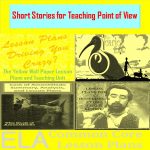My “Secret Life of Walter Mitty” lesson plans were a big hit. The world’s greatest teachers came from throughout the world to congratulate me. Then I dusted off some point of view lesson plans I borrowed from the guy who’d been teaching since 1972 but refused to retire.
It was a disaster.
Nobody learned a thing from these dusty point of view lesson plans. Disgraced, I dug out a rusty stapler and started riveting my eyelids to the filing cabinet. It was then that Mrs. Mitty appeared, handed me short stories for teaching point of view lesson plans, ripped my face from my eyelids (which hung languidly in front of my Of Mice and Men file drawer), and went on her merry way.
I will now share a portion with you.
Here’s the handout you can use for the described assignment. My feelings won’t even be hurt if you download it, use it immediately, and come back another time to read the rest of this great blog post.
Point of View in Literature Defined
We all teach that point of view is the perspective from which a story is told, but teaching mastery requires learning more than just a definition. Here are the levels of learning in regards to teaching imagery.
- Define point of view: You can teach a monkey to recite a definition. It’s simple memorization. It is necessary for mastery but does not come close to achieving it.
- Identify a story’s point of view: You’d have trouble teaching a monkey to identify the point of view in a story (unless it’s a really smart monkey). Most high school students know it when they see it. Simply identifying it, however, has no practical application outside of a classroom. It is not mastery.
- Interpret point of view: Now we’re approaching mastery. Students who can explain the author’s purpose in using a particular point of view and how the point of view relates to the overall theme of the literary work are using critical thinking skills, skills that can be applied outside of the classroom.
- Choose point of view with a purpose: Students who can use point of view to suit a specific purpose in writing or in speech have mastered the concept and are one step closer to becoming a master of words.
Another Point of View on Point of View
For the handout associated with this point of view lesson plan, click.
Point of View can also refer to the cultural perspective from which a story is told. The following lesson plan on point of view can help students understand both aspects of point of view.
- Read a story.
- Instruct students to rewrite a scene from a different point of view. This different point of view can be the literary point of view or the cultural/gender point of view or both.
- This activity works well in a group setting with one person in each group writing from the perspective of a different character, an omniscient narrator, or an outsider.
- Share the same story from a different point of view with the class.
Short Stories for Teaching Point of View in Literature
For more short stories for teaching point of view (including the aforementioned “Secret Life of Walter Mitty”), follow the link.
- “The Scarlet Ibis” by James Hurst – Break out the tissues (and click on the link for more “Scarlet Ibis” lesson plans) as you read the first person account of Doodle’s death from his brother. By employing first person point of view, Hurst allows the reader to identify with his narrator.
- “The Cask of Amontillado” by Edgar Allen Poe – Montresor’s chilling first person account of his plan to kill Fortunato has been a high school favorite for years. Making a character chart comparing the two main characters, from both Montresor’s and Fortunato’s perspective makes for an interesting class discussion. It’s also fun to imagine Fortunato as the first person narrator.
- “The Yellow Wallpaper” by Charlotte Perkins Gillman. And you thought Montressor was crazy? Just mix in a little post partum depression, male oppression, and the loudest yellow wallpaper you’ve ever seen.
- “An Occurrence at Owl Creek Bridge” by Ambrose Bierce. There is a goodly amount of dangerous action–getting hanged from a bridge while being guarded by gun-toting soldiers lends itself to danger. What makes this story so powerful, however, is Bierce’s manipulation of time to reinforce the story’s predominant themes. Understanding the story requires an understanding of this unique point of view.
- “The Story of an Hour” by Kate Chopin. Mrs. Mallard’s husband dies in a train wreck. Mrs. Mallard is sad but happy, more happy than a woman should be whose husband just died in a train wreck. That’s not the only twist in this short classic. How would the story change if the 3rd-person limited narrator told it from Mr. Mallard’s perspective?

